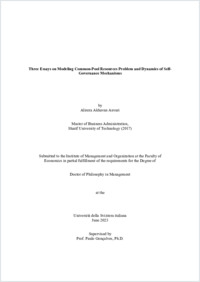Three essays on modeling common-pool resources problem and dynamics of self-governance mechanisms
- Akhavan Anvari, Alireza
- Gonçalves, Paulo (Degree supervisor)
- 2023
PhD: Università della Svizzera italiana, 2023
English
Common-pool resource (CPR) is a natural or human-made resource system whose size or characteristics makes it costly, but not impossible, to exclude potential beneficiaries from benefiting from its use. Fisheries, forests, irrigation systems, and pastures are examples of CPRs. The livelihood of billions of people directly or indirectly depends on CPRs; thus, making it crucial to properly understand and manage these resources. Scholars have long been qualitatively studying and exploring the nature of CPRs, focusing on the self-interested in contrast to shared-interested behavior, open access to natural resources, and overexploitation of these resources (Grossi, 1981; Lloyd, 1833; Maine, 1876; Malinowski, 1926; Marcet, 1828). Gordon (1954) and Schaefer (1957) introduced the first formal analysis by using economic models to examine the fisheries as one type of CPR. They show a maximum sustainable yield (MSY) above which fish stock and revenue decline because of excessive fishing efforts. The results of their study exhibit that in the case of open access, users only account for their own interests neglecting total revenue and total cost, resulting in equilibrium other than MSY. Therefore, several economists proposed that a single owner or government ownership can lead to optimal resource harvest and maximum economic benefit (Crutchfield, 1964; Demsetz, 1967; Johnson, 1972). In line with this research, Hardin argues that a rational actor seeks to maximize his gain from CPR and is locked into a system that compels him to always increase the resource withdrawal—in a limited world. Hardin defines this process as the tragedy of the commons (Hardin, 1968), which is aligned with the concept of prisoners’ dilemma (PD) in game theory developed by economists (Nash, 1951, 1950). Although Hardin’s paper gained significant attention and initiated a vast amount of research in the following decades, some scholars challenged the idea by arguing that the inevitable outcome of PD occurs in one-shot settings where there is no possibility for communication (Axelrod & Hamilton, 1981). The argument was later proved by the publications of field researchers on the geographical and historical prevalence of successful systems of small-scaled community management in limited access CPRs (Berkes, Feeny, McCay, & Acheson, 1989; Feeny, Berkes, McCay, & Acheson, 1990; Gardner, Ostrom, & Walker, 1990; Netting, 1981; Taylor, 1987). The main finding of these studies is that, unlike earlier predictions that CPRs can be managed by a single owner or government ownership, local communities can be more successful in managing and sustaining resources than the state government. Social interactions within the community, and ecological and economic dimensions, have made CPR management a complex and challenging problem. Therefore, CPR research has grown in multiple disciplines, including political science (Ostrom, Walker, & Gardner, 1992), human ecology (Becker & Ostrom, 1995), environmental sciences (Berkes, 2006), anthropology (Agrawal, 2003), behavioral sciences (Sigmund, De Silva, Traulsen, & Hauert, 2010), and more (Poteete, Janssen, & Ostrom, 2010). Despite their usefulness and being highly impactful, these studies have some limitations leading to concerns raised by scholars. First, the research mainly focuses on a simplified case or experimental studies because of the ease of observing self-governance processes (Berkes, 2006). Second, they often lack sophisticated analytical methods making it difficult to capture patterns of outcomes and their corresponding relationship (Agrawal, 2014). Finally, they disregard the comprehensive view of CPRs, ignoring the complexities of social-ecological systems (SES) and the inherent dynamics of such systems (Neudert, Salzer, Allahverdiyeva, Etzold, & Beckmann, 2019). To address these issues, we develop comprehensive system dynamics models (Forrester, 1958; Sterman, 2000), combining ecological, environmental, economic, and behavioral perspectives to capture the complexities and non-linearities of CPR systems in three essays. The first essay focuses on the competition for limited groundwater resources for the case of pistachio production in Rafsanjan, Iran. We show that how some government policies in supporting farmers can result in counterintuitive outcomes and lead to overexploitation of the resources and tragedy of the commons. In the second essay, we show how experimental studies overlooked the effect of feedback, delays, and non-linearities on communication and punishment that are two main elements of self-governance of CPRs. In the third essay, we manifest how systems thinking can promote collective action and enhance the effectiveness of community-based governance of CPRs.
- Collections
- Language
-
- English
- Classification
- Economics
- License
-
License undefined
- Open access status
- green
- Identifiers
-
- NDP-USI 2023ECO003
- URN urn:nbn:ch:rero-006-120645
- ARK ark:/12658/srd1325737
- Persistent URL
- https://n2t.net/ark:/12658/srd1325737
Statistics
Document views: 305
File downloads:
- 2023ECO003: 126
